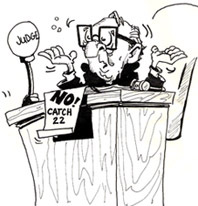
http://www.sparknotes.com/lit/catch22/For other uses, see Catch-22(disambiguation).
| Catch-22 | |
|---|---|
First edition cover | |
| Author(s) | Joseph Heller |
| Coverartist | PaulBacon[1] |
| Country | USA |
| Language | English |
| Genre(s) | Black humor,absurdistfiction, satire, warfiction, historicalfiction |
| Publisher | Simon& Schuster |
| Publication date | 11 November 1961 |
| Mediatype | Print (hardback) |
| Pages | 453 pp (1st edition hardback) |
| ISBN | 0-684-83339-5 |
| OCLCNumber | 35231812 |
| DeweyDecimal | 813/.54 22 |
| LCClassification | PS3558.E476 C3 2004 |
| Followed by | ClosingTime (1994) |
Catch-22 is a satirical, historicalnovel by the American author Joseph Heller. Hebegan writing it in 1953, and the novel was first published in1961. It is set during World War II in1943[2]and is frequently cited as one of the great literary works of thetwentieth century.[3]It uses a distinctive non-chronological third person omniscient narration, describing events fromdifferent characters' points of view and out of sequence so thatthe time line develops along with the plot.
The novel follows Captain John Yossarian, aU.S.Army Air Forces B-25 bombardier,and a number of other characters. Most events occur while theAirmen of the fictional 256th squadron are based on the island ofPianosa, in theMediterraneanSea west of Italy. The phrase "Catch-22", "aproblematic situation for which the only solution is denied by acircumstance inherent in the problem or by a rule,"[4]has entered the Englishlanguage.
Contents[hide] |
[edit]Concept
Among other things, Catch-22 is a general critique ofbureaucraticoperation and reasoning. Resulting from its specific use in thebook, the phrase "Catch-22" is common idiomatic usage meaning "ano-winsituation" or "a double bind" of anytype. Within the book, "Catch-22" is a military rule, theself-contradictory circularlogic that, for example, prevents anyone from avoiding combatmissions. The narrator explains:
There was only one catch and that was Catch-22, which specifiedthat a concern for one's safety in the face of dangers that werereal and immediate was the process of a rational mind. Orr was crazy andcould be grounded. All he had to do was ask; and as soon as he did,he would no longer be crazy and would have to fly more missions.Orr would be crazy to fly more missions and sane if he didn't, butif he were sane he had to fly them. If he flew them he was crazyand didn't have to; but if he didn't want to he was sane and hadto. Yossarian was moved very deeply by the absolute simplicity ofthis clause of Catch-22 and let out a respectful whistle. (p. 56,ch. 5)
Other forms of Catch-22 are invoked throughout the novel tojustify various bureaucratic actions. At one point, victims ofharassment by military police quote the MPs' explanation of one ofCatch-22's provisions: "Catch-22 states that agents enforcingCatch-22 need not prove that Catch-22 actually contains whateverprovision the accused violator is accused of violating." Anothercharacter explains: "Catch-22 says they have a right to do anythingwe can't stop them from doing."
Yossarian comes to realize that Catch-22 does not actuallyexist, but because the powers that be claim it does, and the worldbelieves it does, it nevertheless has potent effects. Indeed,because it does not exist, there is no way it can be repealed,undone, overthrown, or denounced. The combination of force withspecious and spurious legalistic justification is one of the book'sprimary motifs.
The motif of bureaucratic absurdity is further explored in1994's ClosingTime, Heller's sequel to Catch-22. This darker,slower-paced, apocalyptic novel explores the pre- and post-warlives of some of the major characters in Catch-22, withparticular emphasis on the relationship between Yossarian andtailgunner Sammy Singer.
[edit]Synopsis
| This section requires expansion. |
The development of the novel can be split into segments. Thefirst (chapters 1–11) broadly follows the story fragmented betweencharacters, but in a single chronological time in 1943. The second(chapters 12–20) flashes back to focus primarily on the "Great BigSiege of Bologna" before once again jumping to the chronological"present" of 1943 in the third part (chapter 21–25). The fourth(chapters 26–28) flashes back to the origins and growth ofMilo'ssyndicate, with the fifth part (chapter 28–32) returning again tothe narrative "present" but keeping to the same tone of theprevious four. In the sixth and final part (chapter 32 on) whileremaining in the "present" time the novel takes a much darker turnand spends the remaining chapters focusing on the serious andbrutal nature of war and life in general.[5]
While the first five parts "sections" develop the novel in thepresent and through use of flash-backs, the novel significantlydarkens in chapters 32–41. Previously the reader had been cushionedfrom experiencing the full horror of events, but now the events arelaid bare, allowing the full effect to take place. The horrorbegins with the attack on the undefended Italian mountain village,with the following chapters involving despair (DocDaneeka and the Chaplain),disappearance in combat (Orr andClevinger), disappearance caused by the army (Dunbar) or death(Nately, McWatt, Mudd, KidSampson, Dobbs, Chief White Halfoat and Hungry Joe) of most ofYossarian's friends,culminating in the unspeakable horrors of Chapter 39, in particularthe rape and murder of Michaela, whorepresents pure innocence.[5]In Chapter 41, the full details of the gruesome death of Snowden arefinally revealed.
Despite this, the novel ends on an upbeat note with Yossarianlearning of Orr's miraculousescape to Sweden and Yossarian's pledge to follow him there.
[edit]Style
Many events in the book are repeatedly described from differingpoints of view, so the reader learns more about each event fromeach iteration, with the new information often completing a joke,the punchline of which was told several chapters previously. Thenarrative's events are out of sequence, but events are referred toas if the reader is already familiar with them, so that the readermust ultimately piece together a timeline of events. Specificwords, phrases, and questions are also repeated frequently,generally to comic effect.
Much of Heller's prose in Catch-22 is circular andrepetitive, exemplifying in its form the structure of aCatch-22. Heller revels in paradox, for example:"TheTexan turned out to be good-natured, generous and likable. Inthree days no one could stand him", and "The case against Clevinger was open andshut. The only thing missing was something to charge him with."This atmosphere of apparent logical irrationality pervades thebook.
While a few characters are most prominent, notably Yossarian andthe Chaplai————n, the majority of named characters are described indetail with fleshed out or multidimensional personas to the extentthat there are few if any "minor characters."
Although its non-chronological structure may at first seemaleatoric, Catch22 is actually highly structured. A structure of freeassociation, ideas run into one another through seeminglyrandom connections. For example, Chapter 1 entitled "The Texan"ends with "everybody but the CID man, who had caught cold from the fighter captain and comedown with pneumonia."[6]Chapter 2, entitled "Clevinger", begins with "In a way the CID manwas pretty lucky, because outside the hospital the war was stillgoing on."[7]The CID man connects the two chapters like a free associationbridge and eventually Chapter 2 flows from the CID man to Clevingerthrough more free association links.
[edit]Themes
| This article may contain originalresearch. Please improve it by verifyingthe claims made and adding references.Statements consisting only of original research may be removed.More details may be available on the talk page.(February 2012) |
One of the first themes developed in the novel is the questionof what is right to do in a moral-social or prisoner'sdilemma, in which a person can either cooperate with others for agreater communal benefit or act solely to increase one's personalwell-being. Yossarian is presented as embracing the latter option,such as when he, "throbbed with a mighty sense of accomplishmenteach time he gazed at [the officers' club building] and reflectedthat none of the work that had gone into it was his," which castsYossarian as an anti-hero. He asks"why me" when he is conversing about taking risks others would not.Major Danby asks Yossarian, "But suppose everybody on our side feltthat way?", Yossarian replies, "Then I'd certainly be a damned foolto feel any other way. Wouldn't I?"
Another theme is the perversion of notions of right or wrong,particularly patriotism andhonor.
Several themes mingle; "that the only way to survive such aninsane system is to be insane oneself" comments on Yossarian'sanswer to the Social dilemma(that he would be a fool to be any other way) and another theme,"that bad men (who sell out others) are more likely to get ahead,rise in rank, and make money," turns our notions of what isestimable on their heads as well.
Yossarian comes tofear his commanding officers more than he fears the Germansattempting to shoot him down and he feels that "they" are "out toget him." Key among the reasons Yossarian fears his commanders morethan the enemy is that as he flies more missions, ColonelCathcart increases the number of required combat missionsbefore a soldier may return home; he reaches the magic number onlyto have it retroactively raised. He comes to despair of evergetting home and is greatly relieved when he is sent to thehospital for a condition that is almost jaundice. InYossarian's words: "The enemy is anybody who's going to get youkilled, no matter which side he's on, and that includesColonel Cathcart. And don't you forget that, because the longer youremember it, the longer you might live." [8]
While the military's enemies are Germans, none appear in thestory as an enemy combatant. This ironic situation is epitomized inthe single appearance of German personnel in the novel, who act aspilots employed by the squadron's Mess Officer, MiloMinderbinder, to bomb the American encampment on Pianosa. Thispredicament indicates a tension between traditional motives forviolence and the modern economic machine, which seems to generateviolence simply as another means to profit, quite independent ofgeographical or ideological constraints. Heller emphasizes thedanger of profit seeking by portraying Milo without “evil intent;"Milo’s actions are portrayed as the result of greed, notmalice.[9]
- List of Themes/Motifs:
[edit]Characters
Further information: List ofCatch-22 characters[edit]Influences
Heller wanted to be a writer from an early age; his experiencesas a bombardierduring World War II inspired Catch-22;[14]Heller later said that he "never had a bad officer." In a 1977essay on Catch-22, Heller stated that the “antiwar andantigovernment feelings in the book” were a product of the KoreanWar and the 1950s rather than World War II itself. Heller’scriticisms are not intended for World War II but for the Cold Warand McCarthyism.[15]
The influence of the 1950s on Catch-22 isevident through Heller’s extensive use of anachronism.Though the novel is ostensibly set in World War II, Hellerintentionally included anachronisms like loyalty oathsand computers (IBMmachines) to situate the novel in the context of the1950s.[9]Many of the characters are based on or connected to individualsfrom the 1950s. Milo Minderbinder’s maxim “What’s good forM&M Enterprises is good for the country” alludes toformer president of General MotorsCharles ErwinWilson’s statement before the Senate “What’s good for GeneralMotors is good for the country.”[9]The question of “Who promoted Major Major?” alludes to JosephMcCarthy’s questioning of the promotion of Major Peress, anarmy dentist who refused to sign loyalty oaths.[9]
Czech writer Arnošt Lustigrecounts in his book 3x18 that Joseph Heller told him thathe would never have written Catch-22 had he not first readThe GoodSoldier Švejk by JaroslavHašek.[16]
In 1998, some critics raised the possibility that Heller's bookhad questionable similarities to Louis Falstein's 1950 novel,Face of a Hero. Falstein neverraised the issue between Catch-22's publication and hisdeath in 1995 and Heller claimed never to have been aware of theobscure novel. Heller said that the novel had been influenced byCéline,Waugh and Nabokov. Manyof the similarities have been stated to be attributable to theauthors' experiences, both having served as U.S. Air Force aircrewin Italy in World War II. However, their themes and styles aredifferent.[17]
[edit]Literary allusions
Catch-22 contains allusions to many works of literature.Howard Jacobson,in his 2004 introduction to the Vintage Classics publication, wrotethat the novel was "positioned teasingly ... between literature andliterature's opposites– between Shakespeare andRabelais and Dickensand Dostoevsky andGogol and Célineand the Absurdists and ofcourse Kafka on the one hand, andon the other vaudeville andslapstick andBilko andAbbott andCostello and Tom and Jerry andthe Goons (if Hellerhad ever heard of the Goons)."[18]One critic argues that it is Kafka’s influence that can be seenmost strongly in the novel: “Like Kafka’s heroes, Yossarian isriddled with anxiety and caught in an inexorable nightmare – in hiscase created by Colonel Cathcart and the inevitability of himraising the number of missions he has to fly.”[19]
[edit]Explanation of the novel's title
The title is a reference to a fictional bureaucratic stipulationwhich embodies forms of illogical and immoral reasoning. Theopening chapter of the novel was originally published inNew WorldWriting as Catch-18 in 1955, but Heller's agent,Candida Donadio, requested that he change the title of the novel,so it would not be confused with another recently published WorldWar II novel, Leon Uris'sMila 18. The number18 has specialmeaning in Judaism (it means Alive in Gematria) and wasrelevant to early drafts of the novel which had a somewhat greaterJewish emphasis.[20]
The title Catch-11 was suggested, with the duplicated 1paralleling the repetition found in a number of character exchangesin the novel, but because of the release of the 1960 movieOcean'sEleven, this was also rejected. Catch-17 wasrejected so as not to be confused with the World War II filmStalag 17, as wasCatch-14, apparently because the publisher did not feel that14 was a "funny number."Eventually the title came to be Catch-22, which, like 11,has a duplicated digit, with the 2 also referring to a number ofdéjàvu-like events common in the novel.[20]
A 1950s-early 1960s anthology of war stories included a shortversion as "Catch-17".[citationneeded]
[edit]Critical Response
The critical response to the novel was polarized. Reviews inAmerican publications ranged from the very positive to verynegative. The Nation, ("thebest novel to come out in years"), the New YorkHerald Tribune ("A wild, moving, shocking, hilarious,raging, exhilarating, giant roller-coaster of a book") andThe New YorkTimes, ("A dazzling performance that will outrage nearly asmany readers as it delights") praised the novel, while The NewYorker, ("doesn't even seem to be written; instead, itgives the impression of having been shouted onto paper," "whatremains is a debris of sour jokes") and a second critic from theNew York Times ("repetitive and monotonous. Or one can saythat it is too short because none of its many interestingcharacters and actions is given enough play to become a controllinginterest")[21]panned Heller's work.
Although the novel won no awards upon release, it has remainedin print and is seen as one of the most significant American novelsof the 20th century.[3]Scholar and fellow World War II veteran Hugh Nibleysaid it was the most accurate book he ever read about themilitary.[22]
[edit]Rankings
[edit]Adaptations
[edit]Release details
This list covers the first and most recent printed publicationsby the original publisher Simon& Schuster as well as all other formats. Otherprint publishers include Dell, Corgi,Vintage,Knopf, BlackSwan, Grasset & Fasquelle and Wahlström& Widstrand.
The original manuscript is held by BrandeisUniversity.[30]
[edit]See also
| Novels portal |
[edit]Notes and references
- ^"Paul Bacon coverartist". Solothurnli.com. http://www.solothurnli.com/Pages/PaulBacon.html.Retrieved 11 March 2011.
- ^Rosenbaum, Ron(2011-08-02). "SeeingCatch-22 Twice: The awful truth people miss about Heller's greatnovel.". Slate Magazine. http://www.slate.com/id/2300576."There is no mention of Normandy in the novel, the Herman GoeringDivision is still a force to be reckoned with, even the Italiancampaign was not a done deal. Mussolini is still in power in thenovel, so its time frame must be 1943."
- ^ ab "What is Catch-22? Andwhy does the book matter?". BBC News. 12 March 2002.http://news.bbc.co.uk/1/hi/uk/1868619.stm.Retrieved 11 March 2011.
- ^catch-22. 2012. In Merriam-Webster.com. Retrieved March 8,2012, from http://www.merriam-webster.com/dictionary/catch22
- ^ ab Clinton S. Burhans, Jr. Spindriftand the Sea: Structural Patterns and Unifying Elements in Catch22. Twentieth Century Literature, Vol. 19, No. 4, pp. 239–250,1973. JSTOR online access
- ^Joseph Heller, Catch 22 (Simon and Schuster, New York. 1996),p. 24
- ^Joseph Heller, Catch 22 (Simon and Schuster, New York. 1996),p. 25
- ^Heller, Joseph (1961). Catch-22. New York: Simonand Schuster. pp.124.
- ^ abcd Sorkin, Adam J. (1993).Conversations with Joseph Heller. Jackson, MO: UniversityPress of Mississippi. pp.150. ISBN0-87805-635-1.
- ^ abc "Catch-22Themes". bookrags.com. 2 November 2010. http://www.bookrags.com/studyguide-catch22/themes.html.Retrieved 11 March 2011.
- ^ abcd "Catch-22Themes, Motifs and Symbols". sparknotes.com. http://www.sparknotes.com/lit/catch22/themes.html.Retrieved 11 March 2011.
- ^ abcd [http://www.cliffsnotes.com/WileyCDA/LitNote/id-176,pageNum-94.htmlCatch-22 Themes CliffsNotes[deadlink]
- ^DeadlyUnconsious Logics in Joseph Hellier's Catch-22, RM Young –Psychoanalytic Review, 1997
- ^DM Craig. From Avignon to Catch-22. War, Literature,and the Arts 6, no. 2, 1994 pp27-54.
- ^Heller, Joseph (1977). "Reeling in Catch-22". In LyndaRosen Obst. The Sixties. New York: Random House/RollingStone Press. pp.50–52.
- ^Zenny Sadlon. "Personal testimony by ArnoštLustig". Zenny.com. http://www.zenny.com/Heller.html.Retrieved 11 March 2011.
- ^Gussow, Mel (29 April 1998). "Critic's Notebook; Questioning the Provenance of the Iconic'Catch-22'". The New York Times. http://www.nytimes.com/1998/04/29/books/critic-s-notebook-questioning-the-provenance-of-the-iconic-catch-22.html?pagewanted=all.Retrieved 1 April 2010.
- ^Random HouseISBN978-0-09-947046-5 VintageClassics
- ^McDonald,Paul. Reading Catch-22. Humanities E-Books
- ^ ab N James. "The Early CompositionHistory of Catch-22". In Biographies of Books: The CompositionalHistories of Notable American Writings, J Barbour, T Quirk(edi.) pp. 262–290. Columbia: University of Missouri Press,1996.
- ^"TheInternet Public Library: Online Literary Criticism Collection".Ipl.org. http://www.ipl.org/div/litcrit/bin/litcrit.out.pl?ti=cat-860.Retrieved 11 March 2011.
- ^Hugh Nibley and Alex Nibley, Sergeant Nibley PhD.:Memories of an Unlikely Screaming Eagle, Salt Lake City: ShadowMountain, 2006, p. 255
- ^Randomhouse.comModern Library's100 best novels of the twentieth century
- ^Herbert Huber. "Radcliffe PublishingCourse: the twentieth century's top100novels". Lesekost.de. http://www.lesekost.de/kanon/HHL102.htm.Retrieved 11 March 2011.
- ^Robert McCrum (8 August 2006). "TheObserver's greatest novels of all time". The Observer(UK). http://observer.guardian.co.uk/review/story/0,,1061037,00.html.Retrieved 11 March 2011.
- ^"Time'stop 100 English language modern novels". TIME. 16October 2005. http://www.time.com/time/2005/100books/the_complete_list.html.Retrieved 11 March 2011.
- ^TheBBC's Big Read
- ^Phythyon Jr., John. R. (2 March 2008). "Catch-22 a nearly perfect adaptation". The LawrenceJournal-World & News. http://www2.ljworld.com/news/2008/mar/02/catch22_nearly_perfect_adaptation.
- ^Catch-22 at theInternet Movie Database
- ^Heller archive, Brandeis University
[edit]External links
| Wikiquote has a collection of quotations related to:Catch-22 |
 爱华网
爱华网


